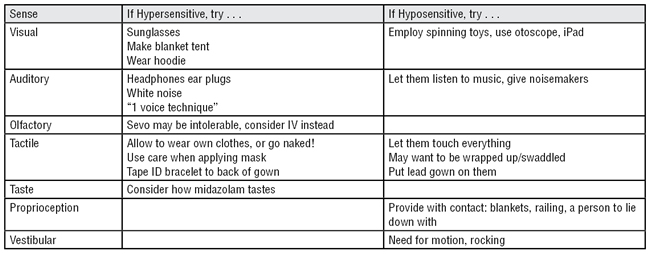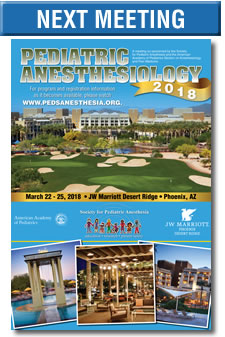Meeting Reviews
Session IV - Holistic Care of Special Needs Children: It takes a village to raise a child
By Kate Gentry, MD, MA
Seattle Children’s Hospital
The second half of this session focused on features of Autism Spectrum Disorder (ASD) and techniques anesthesiologists can employ to help children with autism navigate the perioperative period.
The first of these talks, “Considering Developmental Differences in the Perioperative Care of Children with Special Needs”, was delivered by Alexandra Ross, PhD, a pediatric psychologist from Stanford University. Dr. Ross’s talk provided a framework by which to understand how the perioperative experience can be particularly challenging for children with ASD.
I was interested to learn that the diagnosis of autism and its diagnostic criteria changed with the latest edition of the DSM in 2013. The past definition of autism (DSM-IV) listed the following in the category of “Pervasive Developmental Disorders":
- Autistic disorder
- Asperger’s disorder
- Pervasive developmental disorder - not otherwise specified
- Rett's disorder
- Childhood Disintegrative Disorder
With the publication of the DSM-5, the first three diagnoses listed above have been collapsed into “Autism Spectrum Disorder” aka ASD. The features of ASD are characterized by (1) deficits in social communication and interaction and (2) restricted and repetitive behavior, interests, and activities. Within these realms, the severity of communication deficits and repetitive behaviors can be specified, as well as the degree of intellectual and language impairment. Thus, if a child presents with a diagnosis of Asperger’s disorder you can bet that he/she was diagnosed prior to 2013; a child with a similar profile diagnosed more recently might be described as having ASD with mild communication deficits and no intellectual impairment.
Dr. Ross discussed four realms of which we should be aware when trying to understand the experience of children with autism: physical sensations, behaviors, thoughts, and emotions. These elements were captured with a video from the child’s perspective in a shopping mall; the crowds, lights, noises, and smells are overstimulating and the child experiences sensory overload. In an attempt to modulate this overstimulation, the child starts to display repetitive behaviors such as counting on his fingers. When it all becomes too much, he crouches down in the middle of the mall, attempts to covers his ears, and yells “no, no!” The video closes with a voiceover, “I’m not naughty, I’m autistic, and I just get too much information.” This video can be viewed at https://www.youtube.com/watch?v=Lr4_dOorquQ.
Unusual behaviors displayed by children with autism can fall into two major categories: “stimming”—such as rocking or tapping, which is a way the child manages sensory information, and “meltdown” -- which can be a verbal or physical explosion or loss of control that indicates that the child is overwhelmed and in need of support.
A key point of this talk was that children with autism spectrum disorder have an uneven profile of development—they acquire skills at different rates. It is therefore important to ask parents about their child’s specific strengths and weaknesses. A couple of other details I found helpful were (1) some kids communicate best with picture cards called “pecs cards” or other assistive communication devices, (2) many kids will cooperate when given a “first, then” scenario, such as “First we are going to put this sticker on your finger, and then you will breathe through this mask.”
Lastly, Dr. Ross emphasized that you can engage parents by asking questions about their child’s sensory needs and styles of communication; by doing so you recognize the parents’ expertise and engage in family-centered care.
Camilla Sutter is a child life specialist at Newton-Wellesley Hospital whose talk was titled “Not Bad, Just Different: Working with Patients with ASD.” This was one of the most engaging and applicable lectures of the entire day, and it dovetailed nicely with the framework provided by Dr. Ross.
Ms. Sutter stated that kids with ASD fall on a spectrum of sensitivity to stimuli. On one end is the hypersensitive child, who becomes overwhelmed and uncomfortable with minor sensations; on the other end is the hyposensitive child, who seeks additional sensory input to be content. Understanding where your patient falls on this spectrum helps you tailor the perioperative experience to minimize negative behavioral responses and maximize cooperation.
As she listed the various sensory features of the operating room, Ms. Sutter provided tips and tricks for both the hypersensitive and hyposensitive child.

Ms. Sutter also talked about the differences between “stimming” and “meltdowns.” With regard to meltdowns, she emphasized that the best way to help kids get over them is to minimize interventions, delay the procedure, medicate as necessary, get them into a quiet, calm, and dark place. Calling security is not likely to be helpful unless there is an imminent threat to safety. It is better to let the child’s family handle the meltdown.
She concluded with seven tips for working with children with autism:
- Ask caregivers, “Tell me about your child . . .”
a - What overwhelms or settles them?
b - What can we do to make this day go smoothly? - Change the environment: dim lights, voices down
- Pick your battles, particularly regarding wearing a hospital gown, socks, or ID tags.
- Rehearse the induction with the child counting to a specific number
- Try "one voice technique": designate only one person who can talk during the induction (the parent, the nurse, yourself). Everyone else MUST be silent!
- Give timing cues: use timers, countdowns
- Be creative and flexible (e.g. induction under a tent of blankets)
I want to thank the meeting organizers for including this panel about caring for kids with developmental challenges. This session not only enhanced my medical knowledge, it enhanced my sensitivity to the struggles and needs of kids with developmental disabilities and provided me with techniques I could put into practice right away. It was truly one of the best sessions I have attended at SPA meetings.






